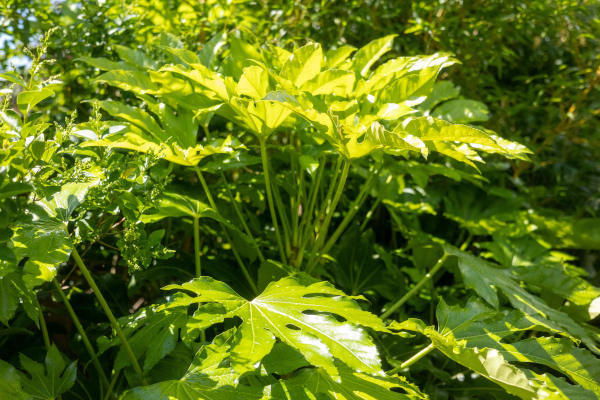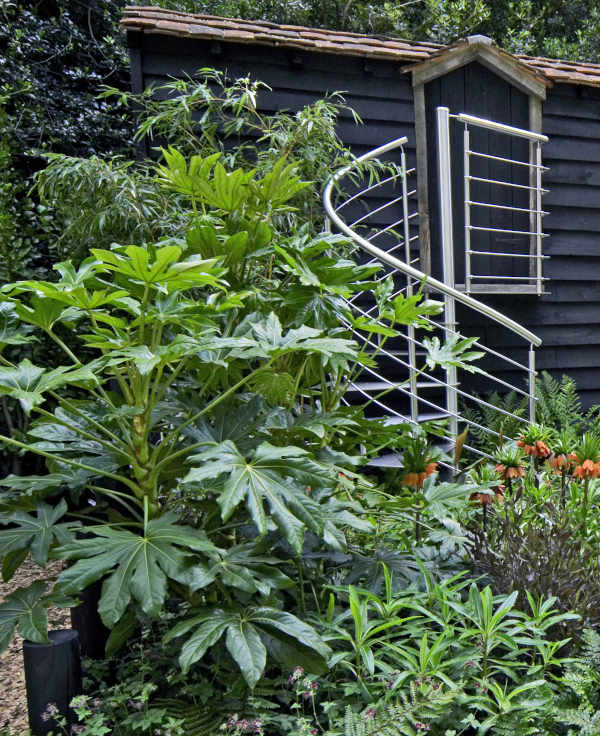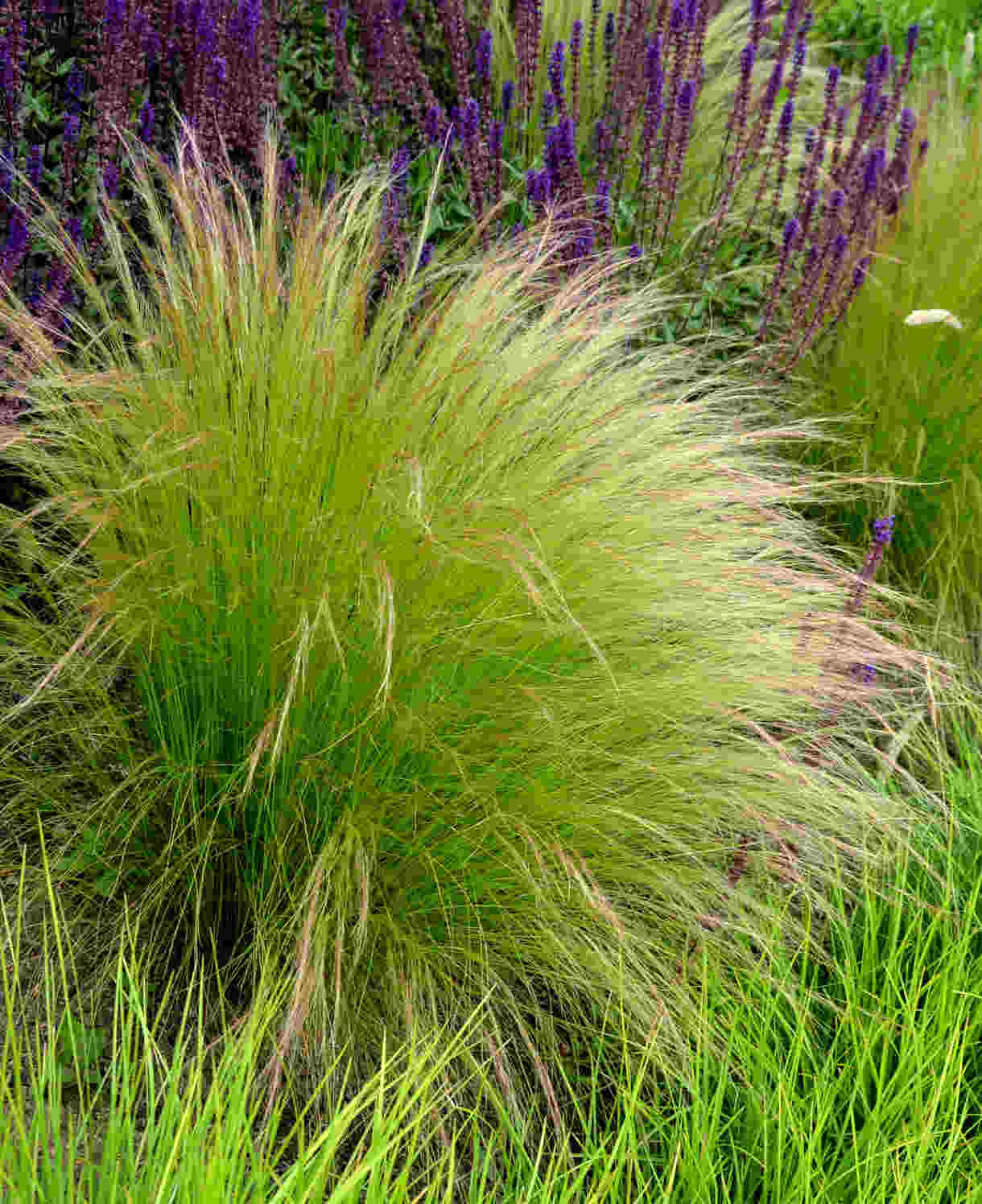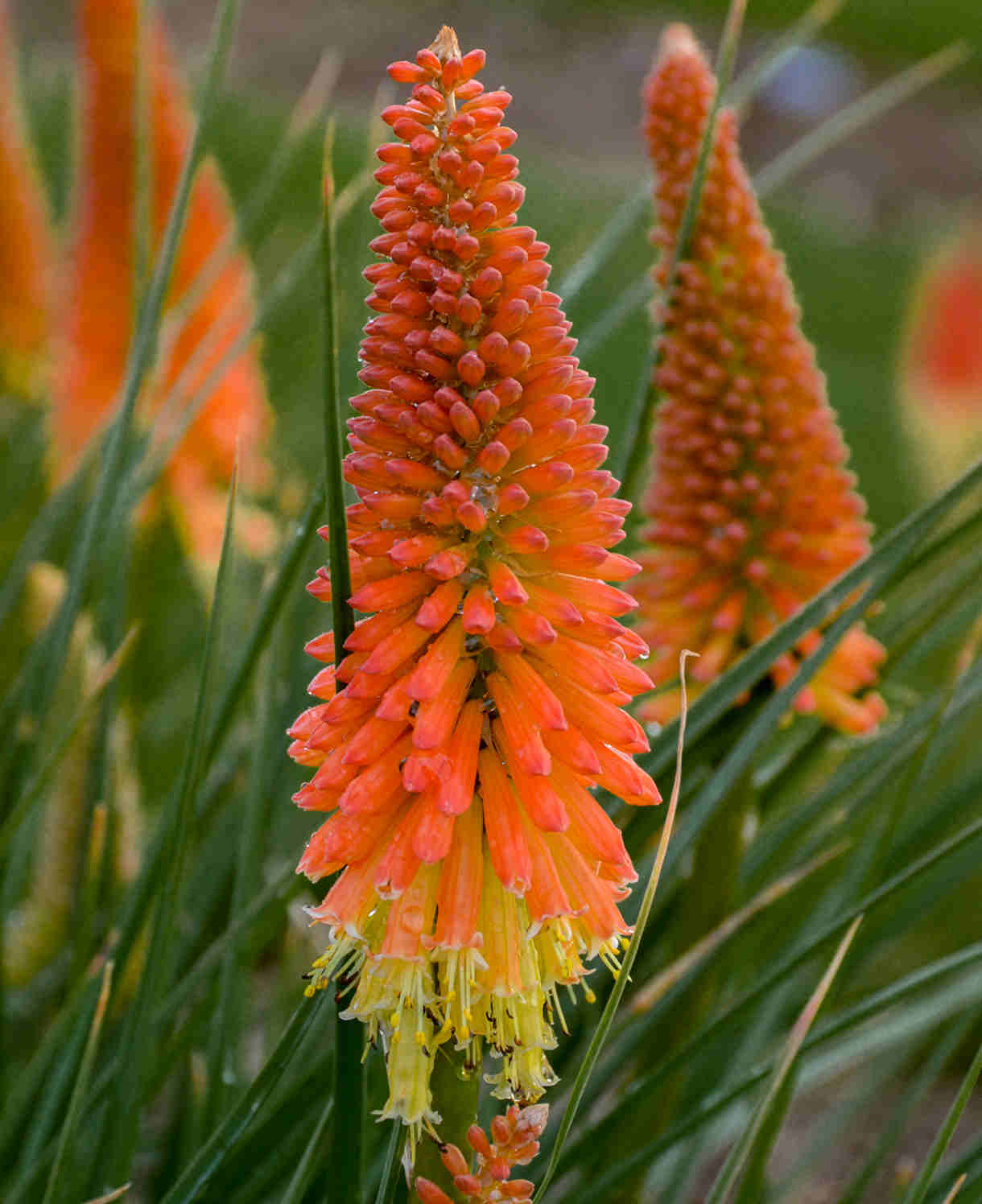How to grow Fatsia
A large leaved evergreen which was originally brought to the western world as a houseplant in the early 1800s from Southern Japan and is a member of the ginseng family. Today these architectural plants thrive both indoors and out if given an appropriate location and, despite its large and exotic looking foliage, Fatsia japonica is surprisingly hardy. Also, it makes a great ‘on trend’ jungle plant, especially located at the back of a border where its lush, waxy green leaves create a generous backdrop. Leaves are roughly palm shaped with a star-like appeal and each leaf has around seven to nine lobes (or fingers) and can reach up to 45 centimetres in span. We supply two varieties of Fatsia japonica at present so the ‘how to grow’ notes relate to these (Fatsia japonica and Fatsia japonica ‘Spider’s Web’).
Fatsia japonica is also known as the Castor Oil Plant, Fig-leaf Palm and Japanese aralia and intriguing white, spherical flowers are borne on mature plants from September to October each year, developing into black, inedible fruit afterwards. Unfussy on soil type, Fatsia japonica is particularly useful if you garden on clay as is happy in heavy soils as much as sandy ones. Outdoors, in nature, these plants grow up to 5 metres tall over 10-20 years, although compact and variegated varieties are widely available.
It is noteworthy that Fatsia japonica is not toxic to dogs, cats or humans – despite claims being made a few years ago that it was. Equally, it is no particular value to birds and wildlife as sustenance either. It is even advised to remove flowers before the berries develop as their formation draws energy away from the production of large leaves.

Zantedeschia is a genus of flowering plants from the family Araceae and is native to southern Africa. With a rich history dating back to the Ancient Romans, these deciduous or semi-evergreen perennials have been used as a symbol of celebration. Zantedeschia was Named after Professor Giovanni Zantedeschia, an Italian botanist.
There are two main forms of Zantedeschia: hardy and tender. Hardy forms of the plant can be grown outdoors, enjoy moist soil and full sun or partially shaded conditions - these are known as Arum lilies. Tender forms of Zantedeschia prefer being grown in containers or pots and should be brought inside over the winter - these are known as Calla lilies.
With tuberous flora in all colours from whites, yellows and oranges to deep reds and purples, Zantedeschias are not to be overlooked in any garden, as long as they have sufficient sunlight to grow in.
Ready to learn more about growing Zantedeschia? Read on for all there is to know...

Key Information
Soil pH
Position
Hardiness


Where & when to plant Fatsia
Position- Sun or shade of any aspect – happiest in dappled shade
Soil- Happy in moist, well-drained soil
Flowering Period- September to October with berries in November and December
Hardiness- A hardy (H4 and H5), evergreen shrub
Ideal for gardens which are not prone to very heavy frosts as Fatsia japonica ‘Spiders Web’ is H4 hardy (-5 to -10°C) and Fatsia japonica H5 hardy (-10 to -15°C). We advise planting in a spot with a degree of shelter as leaves may be damaged by frost, although the plant as a whole will be fine and recover quickly as long as its roots are protected. Unfussy on soil or aspect Fatsia japonica is also happy in containers, gravel gardens, seaside gardens and even as a houseplant whilst it is small enough! A shade tolerant beauty of which one variety, Fatsia japonica, holds the RHS Award of Garden Merit for its outstanding in the garden.
Can be planted at any time of year, although it will have plenty of time to establish a good root structure if you plant it (outside) in the spring after the risk of frost has passed if your Fatsia has not been hardened off. When planting bear in mind Fatsia japonica ‘Spiders Web’ reaches a height and spread of 2.5 metres, whilst Fatsia japonica reaches a height and spread of up to 4 metres. Any pruning, if needed to remove fading branches or restrict size, should be done in mid to late spring.
How to plant Fatsia
Your Fatsia japonica can either be planted in open ground or in a suitably sized pot. Ideally, if your plant is relatively young and smaller on arrival, it is best nurtured in a pot whilst it establishes a good root structure ready for planting out in the border or gravel garden.
For planting in containers, first choose an appropriately sized pot and ensure that you do not swamp your plant by choosing too large a container.
- If you are using a large or heavy pot, it can be a good idea to fill and plant it in situ to save yourself the trouble of moving once full.
- Use a good quality, and, if not already present in the compost (check the description on the bag) some suitable slow-release fertiliser granules.
- Start by partially filling the pot with compost; enough so that when placed on it the upper surface of the root ball is about 3cm lower than the top of the pot.
- Infill all the space surrounding the root ball with compost, firming down with your fingers then adding a little more so the plant is held tight.
- Pick up the container (if able) and lightly tap on the potting bench or ground a few times to help further settle the compost around the plant.
- Water well, preferably with rainwater, to both settle the soil and give the plant a good drink.
- A mulch with horticultural grit will look attractive and help to prevent a ‘cap’ or crust forming on the top of the compost (something container plants can suffer due to the artificial nature of their watering).
For planting in the garden, ensure you choose a spot with appropriate levels of sun and shade so as not to scorch your plant or deprive it of light
- dig the soil area removing any large stones and weeds and breaking up any lumps. Mix in some organic matter and/or compost into the soil. If your soil is heavy clay, now is also the time to add a generous helping of horticultural grit.
- Rake level and firm with your heels. Rake level again.
- Water plants well and allow to drain before planting. A good tip is to dig a hole twice the size of the root-ball.
- Place the plant in the hole, ensuring the top of the root ball sits level with the surface of the soil. Too low and the plant may rot, too high and the roots can dry out.
- Backfill with soil and firm in gently with your foot.
- Soak well with water to settle the surrounding ground. Feed regularly and water as needed for the first few weeks as your plant establishes.

What to plant with Fatsia
These shrubs are beautiful in their own right and ideal for locating anywhere in the garden which offers the necessary protection and allows you to make the most of the beautiful foliage. They combine well with other jungle plants or shade lovers.



How to care for Fatsia
Pruning
Where pruning is required, do it in mid to late spring. Plants can, however, be left unpruned to naturalise freely if space allows.
Watering
Water your new plant regularly for at least the first two years. Once established, it should cope well without extra watering, except in particularly hot, dry spells.
Feeding
Once established your Fatsia japonica will benefit from a general purpose feed, particularly in late spring and summer. If you are growing in a container then feeding monthly between more regularly during the growing season will be beneficial. Also repot as and when required, replenishing the compost each time.
Pests and Diseases
Fatsia japonica can be prone to an aphid infestation. This is easily eradicated by spraying with a soap and water mix or proprietary treatment if you prefer. Capsid bugs can also take up residence – eating new leaves and damaging the flowers. Again spray, this time with an insecticide. You may also find certain caterpillars take a liking to your Fatsia – just pick them off and dispose of far away from your plant.
Fungal infections can spring unexpectedly and result in blotchy-looking leaves. To prevent infections from spreading, always allow plenty of air circulation between plants. You can achieve this by weeding out anything getting in the way of your plant and by removing branches which appear to be clogging up others.
Shot hole disease is another fungal infection which leads to holes in the leaves. The best way to treat this is to remove and burn the affected leaves to avoid spread and remember to disinfect any tools used.
How to propagate Fatsia
This can be done by semi-ripe (or semi-hardwood) cuttings in summer. Semi-ripe cuttings are straightforward way to propagate a wide range of shrubs and trees – especially evergreens – without the need of special equipment or skills.
- Select the cuttings from this season’s growth and remove them using sharp secateurs.
- Place the cuttings in a plastic bag straight away. Keep the bag in the shade and aim to pot the cuttings within 12 hours.
- Prepare the cuttings by trimming them to 10-15cm long, cutting just below a leaf node. Next, remove the lowest leaves and the soft tips. There will be about four leaves remaining. If leave are large, cut them on half to reduce transpiration.
- Dip the bottom of the cutting in fresh hormone rooting powder, ensuring that the cut is well covered. Tap to remove any excess.
- Insert the cuttings around the edge of a suitably sized containers allowing some space between each and use filled with cuttings use 50 per cent free-draining potting compost mixed with 50 per cent sharp sand or perlite. Water well and allow to drain.
- Place the container of cuttings in a greenhouse. Alternatively, cover pots with a plastic bag and put in a warm, light position, out of direct sunlight.
- Remember to remove any excess moisture to prevent rot but keep the compost damp. Cuttings taken in summer seldom need bottom heat but by autumn cuttings will root more quickly in a heated propagator.
- Transfer to separate pots once a good root structure has been achieved for each cutting and grow on as for young plants.
* Please be aware that many plants carry Plant Breeders Rights and cannot be propagated for commercial purposes.
Common Fatsia questions
- Is Fatsia japonica easy to grow?
Yes, as long as it is provided with a degree of shelter from cold winds and planted in a spot which is not prone to exceptionally severe frosts.
- Will my Fatsia japonica last?
Plants mature over 10-20 years and will live longer than this.
- Which areas of the garden suit my Fatsia japonica best?
An easy-going shrub which is perfect for
Architectural planting
Cottage and informal gardens
City and courtyard gardens
Patio and container plants
Low Maintenance gardens
Wildlife gardens
Also suitable as a houseplant





